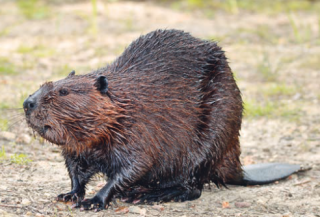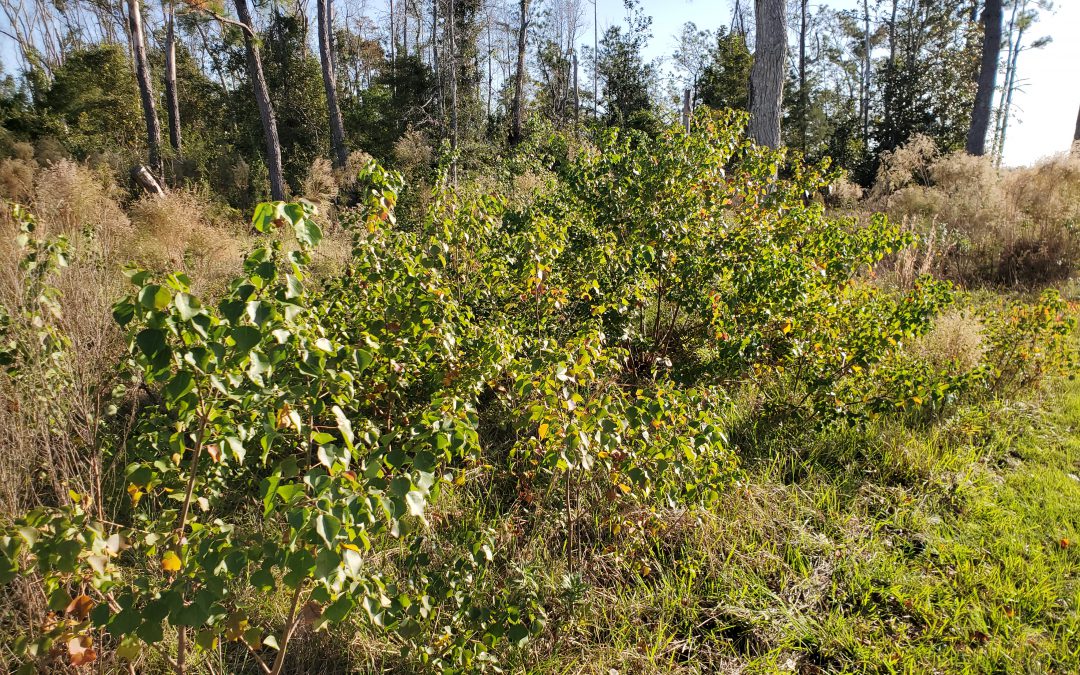
by Daniel J. Leonard | Nov 18, 2020
The native Florida landscape definitely isn’t known for its fall foliage. But as you might have noticed, there is one species that reliably turns shades of red, orange, yellow and sometimes purple, it also unfortunately happens to be one of the most significant pest plant species in North America, the highly invasive Chinese Tallow or Popcorn Tree (Triadica sebifera).
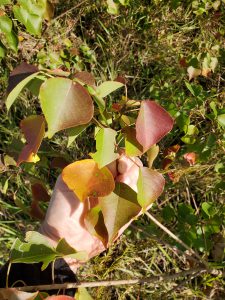
Chinese Tallow fall foliage. Photo courtesy of Daniel Leonard.
Native to temperate areas of China and introduced into the United States by Benjamin Franklin (yes, the Founding Father!) in 1776 for its seed oil potential and outstanding ornamental attributes, Chinese Tallow is indeed a pretty tree, possessing a tame smallish stature, attractive bark, excellent fall color and interesting white “popcorn” seeds. In addition, Chinese Tallow’s climate preferences make it right at home in the Panhandle and throughout the Southeast. It requires no fertilizer, is both drought and inundation tolerant, is both sun and shade tolerant, has no serious pests, produce seed preferred by wildlife (birds mostly) and is easy to propagate from seed (a mature
Chinese Tallow tree can produce up to 100,000 seeds annually!). While these characteristics indeed make it an awesome landscape plant and explain it being passed around by early American colonists, they are also the very reasons that make the species is one of the most dangerous invasives – it can take over any site, anywhere.
While Chinese Tallow can become established almost anywhere, it prefers wet, swampy areas and waste sites. In both settings, the species’ special adaptations allow it a competitive advantage over native species and enable it to eventually choke the native species out altogether.
In low-lying wetlands, Chinese Tallow’s ability to thrive in both extreme wet and droughty conditions enable it to grow more quickly than the native species that tend to flourish in either one period or the other. In river swamps, cypress domes and other hardwood dominated areas, Chinese Tallow’s unique ability to easily grow in the densely shaded understory allows it to reach into the canopy and establish a foothold where other native hardwoods cannot. It is not uncommon anymore to venture into mature swamps and cypress domes and see hundreds or thousands of Chinese Tallow seedlings taking over the forest understory and encroaching on larger native tree species. Finally, in waste areas, i.e. areas that have been recently harvested of trees, where a building used to be, or even an abandoned field, Chinese Tallow, with its quick germinating, precocious nature, rapidly takes over and then spreads into adjacent woodlots and natural areas.
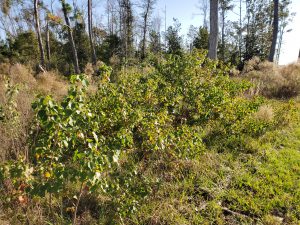
Chinese tallow seedlings colonizing a “waste” area. Photo courtesy of Daniel Leonard.
Hopefully, we’ve established that Chinese Tallow is a species that you don’t want on your property and has no place in either landscapes or natural areas. The question now is, how does one control Chinese Tallow?
- Prevention is obviously the first option. NEVER purposely plant Chinese Tallow and do not distribute the seed, even as decorations, as they are sometimes used.
- The second method is physical removal. Many folks don’t have a Chinese Tallow in their yard, but either their neighbors do, or the natural area next door does. In this situation, about the best one can do is continually pull up the seedlings once they sprout. If a larger specimen in present, cut it down as close to the ground as possible. This will make herbicide application and/or mowing easier.
- The best option in many cases is use of chemical herbicides. Both foliar (spraying green foliage on smaller saplings) and basal bark applications (applying a herbicide/oil mixture all the way around the bottom 15” of the trunk. Useful on larger trees or saplings in areas where it isn’t feasible to spray leaves) are effective. I’ve had good experiences with both methods. For small trees, foliar applications are highly effective and easy. But, if the tree is taller than an average person, use the basal bark method. It is also very effective and much less likely to have negative consequences like off-target herbicide drift and applicator exposure. Finally, when browsing the herbicide aisle garden centers and farm stores, look for products containing the active ingredient Triclopyr, the main chemical in brands like Garlon, Brushtox, and other “brush/tree & stump killers”. Mix at label rates for control.
Despite its attractiveness, Chinese Tallow is an insidious invader that has no place in either landscapes or natural areas. But with a little persistence and a quality control plan, you can rid your property of Chinese Tallow! For more information about invasive plant management and other agricultural topics, please contact your local UF/IFAS Extension office!
References:
Langeland, K.A, and S. F. Enloe. 2018. Natural Area Weeds: Chinese Tallow (Sapium sebiferum L.). Publication #SS-AGR-45. Printer friendly PDF version: https://edis.ifas.ufl.edu/pdffiles/AG/AG14800.pdf
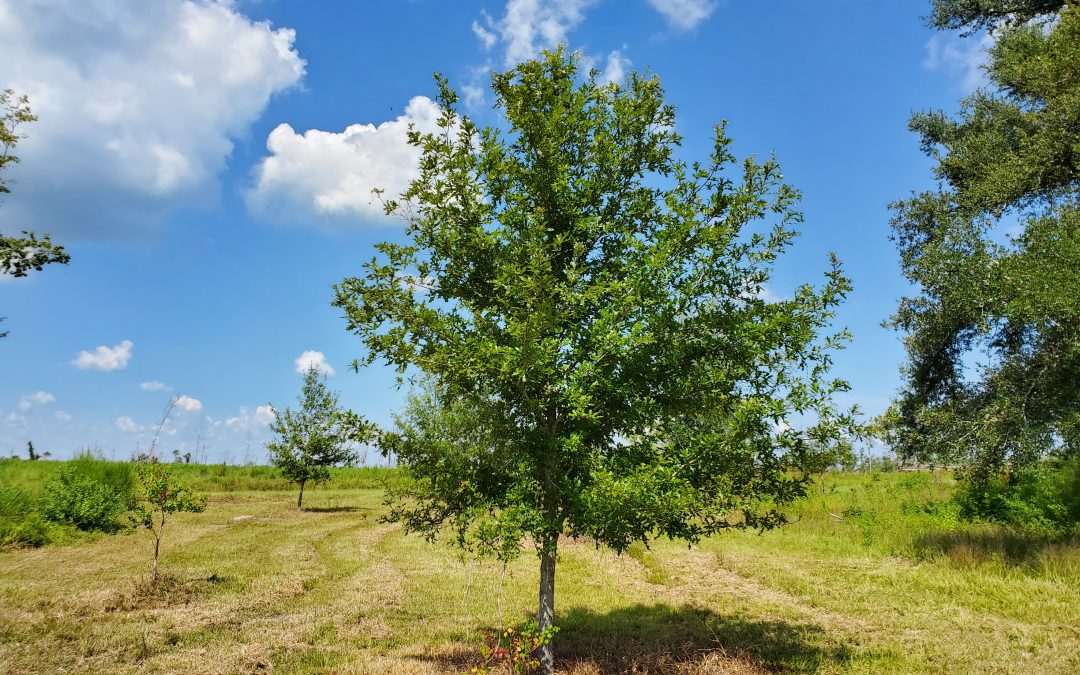
by Daniel J. Leonard | Sep 3, 2020
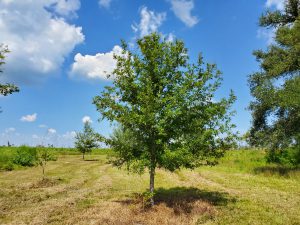
Overcup on the edge of a wet weather pond in Calhoun County. Photo courtesy of Daniel Leonard.
Haunting alluvial river bottoms and creek beds across the Deep South, is a highly unusual oak species, Overcup Oak (Quercus lyrata). Unlike nearly any other oak, and most sane people, Overcups occur deep in alluvial swamps and spend most of their lives with their feet wet. Though the species hides out along water’s edge in secluded swamps, it has nevertheless been discovered by the horticultural industry and is becoming one of the favorite species of landscape designers and nurserymen around the South. The reasons for Overcup’s rise are numerous, let’s dive into them.
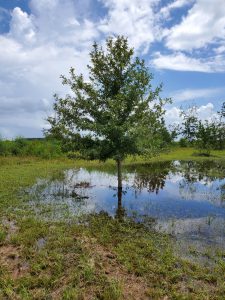
The same Overcup Oak thriving under inundation conditions 2 weeks after a heavy rain. Photo courtesy Daniel Leonard.
First, much of the deep South, especially in the Coastal Plain, is dominated by poorly drained flatwoods soils cut through by river systems and dotted with cypress and blackgum ponds. These conditions call for landscape plants that can handle hot, humid air, excess rainfall, and even periodic inundation (standing water). It stands to reason our best tree options for these areas, Sycamore, Bald Cypress, Red Maple, and others, occur naturally in swamps that mimic these conditions. Overcup Oak is one of these hardy species. It goes above and beyond being able to handle a squishy lawn, and is often found inundated for weeks at a time by more than 20’ of water during the spring floods our river systems experience. The species has even developed an interested adaptation to allow populations to thrive in flooded seasons. Their acorns, preferred food of many waterfowl, are almost totally covered by a buoyant acorn cap, allowing seeds to float downstream until they hit dry land, thus ensuring the species survives and spreads. While it will not survive perpetual inundation like Cypress and Blackgum, if you have a periodically damp area in your lawn where other species struggle, Overcup will shine.
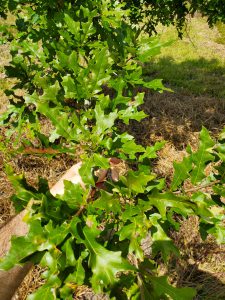
Overcup Oak leaves in August. Note the characteristic “lyre” shape. Photo courtesy Daniel Leonard.
Overcup Oak is also an exceedingly attractive tree. In youth, the species is extremely uniform, with a straight, stout trunk and rounded “lollipop” canopy. This regular habit is maintained into adulthood, where it becomes a stately tree with a distinctly upturned branching habit, lending itself well to mowers and other traffic underneath without having to worry about hitting low-hanging branches. The large, lustrous green leaves are lyre-shaped if you use your imagination (hence the name, Quercus lyrata) and turn a not-unattractive yellowish brown in fall. Overcups especially shine in the winter when the whitish gray shaggy bark takes center stage. The bark is very reminiscent of White Oak or Shagbark Hickory and is exceedingly pretty relative to other landscape trees that can be successfully grown here.
Finally, Overcup Oak is among the easiest to grow landscape trees. We have already discussed its ability to tolerate wet soils and our blazing heat and humidity, but Overcups can also tolerate periodic drought, partial shade, and nearly any soil pH. They are long-lived trees and have no known serious pest or disease problems. They transplant easily from standard nursery containers or dug from a field (if it’s a larger specimen), making establishment in the landscape an easy task. In the establishment phase, defined as the first year or two after transplanting, young transplanted Overcups require only a weekly rain or irrigation event of around 1” (wetter areas may not require any supplemental irrigation) and bi-annual applications of a general purpose fertilizer, 10-10-10 or similar. After that, they are generally on their own without any help!
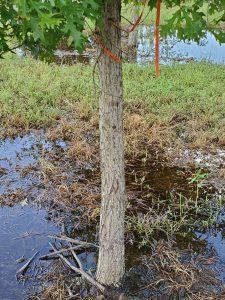
Typical shaggy bark on 7 year old Overcup Oak. Photo courtesy Daniel Leonard.
If you’ve been looking for an attractive, low-maintenance tree for a pond bank or just generally wet area in your lawn or property, Overcup Oak might be your answer. For more information on Overcup Oak, other landscape trees and native plants, give your local UF/IFAS County Extension office a call!
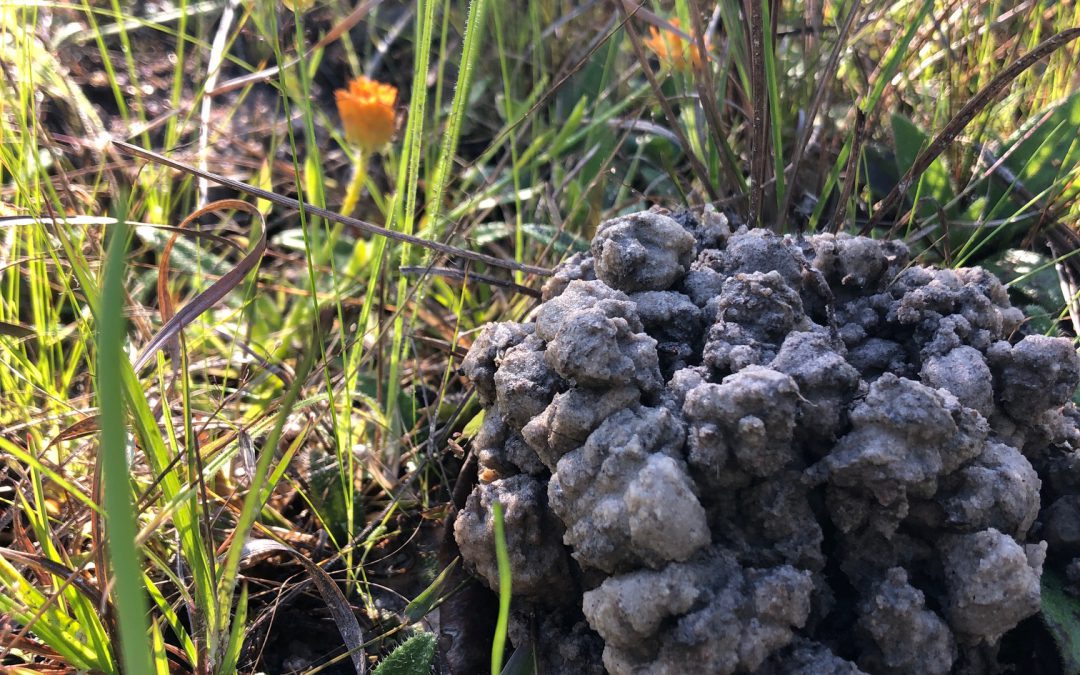
by Carrie Stevenson | May 15, 2020
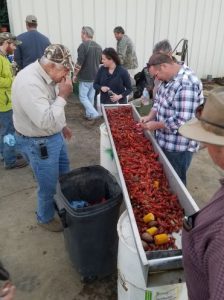
Crawfish boils are popular in the springtime. Crawfish are generally harvested from aquaculture operations. Photo credit: Libbie Johnson, UF IFAS Extension
“You get a line, I’ll get a pole, we’ll go down to the crawdad hole, honey, baby, mine“…there are lots of great zydeco songs singing the praises of crawfish (aka crayfish, crawdads, mudbugs). They are in season now, and while crawfish festivals all around the southeast are canceled due to concerns over COVID-19, they are still available and make for great eating. Most of us would recognize a cooked one alongside a feast of corn and potatoes, but would you know an actual crawfish hole if you came up on it?
Last fall, our office welcomed about 500 kids (over several days) to the 4-H camp in Barrineau Park for a field trip. I showed every single one of them a small muddy mound with an opening in the top, and asked if anyone could tell me what it was. Not a single kid knew! Now, I make sure I point crawfish mounds out to anyone I happen to be walking with, as they are fascinating little structures. Also referred to as crawfish chimneys due to their upright, open construction, they are built by a crawfish in a muddy area, often near a creek or other water source.
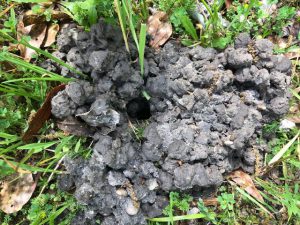
Crawfish mounds are constructed using small pellets of mud, and the opening connects down to a burrow. Photo credit: Carrie Stevenson, UF IFAS Extension
The industrious invertebrate uses its legs and mouth to create pellets of mud as it digs its burrow. It places mud up above the ground, using the mud balls like small bricks. Bricking up the entrance to its burrow (as opposed to placing discarded mud elsewhere) also protects a crawfish from exposure to predators on open soil. The crawfish chimneys can be 6 inches tall (or more!) and connect down to a burrow that may reach 3 feet deep, some straight down and others with side tunnels extending different directions.
Since the crawfish lives in wetland areas, it is theorized that these chimneys extending above the soil allow for better oxygen flow in the burrow. During a drought, crawfish will plug the opening of their mounds with mud, to keep water in the burrow from evaporating.
Crawfish in the wild are rarely harvested, although some folks do fish for them like the song referenced earlier. For the vast majority of crawfish harvested in commercial production, two species are the most popular–the white river crawfish (Procambarus zonangulus) and red swamp crawfish (Procambarus clarkii). They are typically farmed in coordination with rice, as both commodities thrive in flooded conditions. Most aquaculture operations are associated with Louisiana, but at least five other southern U.S. states farm crawfish. To learn more about this industry, check out LSU AgCenter’s informative video.
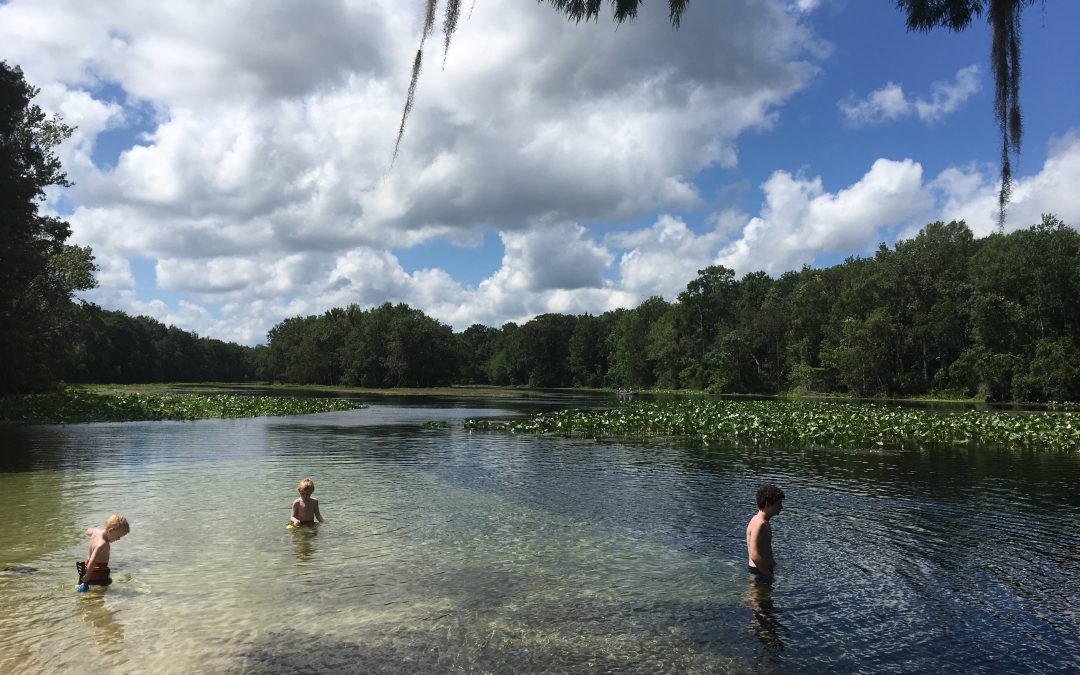
by Les Harrison | Sep 28, 2018
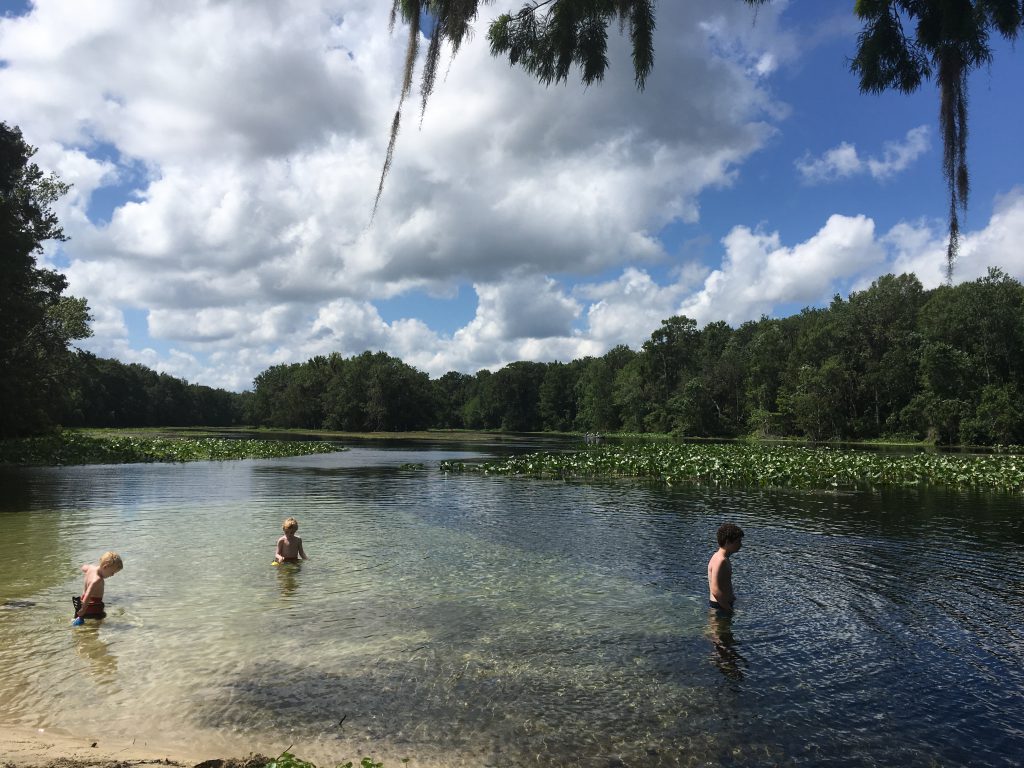
The Wacissa River offers paddlers the opportunity to see north Florida unfiltered.
Being off the beaten path has many advantages. In the case of a spring-fed river, it translates to less pressure from human use and a great opportunity for those who do visit to experience the “real Florida”.
The Wacissa River, located in the southern half of Jefferson County, Florida, is near the crossroads identified as the town of Wacissa. There is a blinking light, a post office, and two small convenience stores where beer, ice and snacks can be purchased.
Access to the river is about two miles south of the blinking light on Florida 59, just after the state road veers to the southwest. The blacktop spur quickly become a dirt parking lot after passing several canoe and kayak rental businesses.
A county maintained boat landing with pick-nic tables, a manmade beach, and a tiny diving platform with a rope swing are the only signs of civilization. The cold, clear water extends to a tree line several hundred yards south of the landing with the river moving to the southeast.
The river emerges crystal clear from multiple limestone springs along the first mile and a half of the 12 mile waterway. The adjacent land is flat and subject to being swampy, especially in wet years like 2018.
The river terrain stands in contrast to the Cody Scarp just a few miles to the north. This geologic feature is the remnants of an ancient marine terrace and is hilly, rising 100 feet above the river in some spots.
Cypress, oak, pine, and other trees cover the bottomlands adjacent to the river. The river quickly enters the Aucilla Wildlife Management Area which results in a wide variety of animals, birds, amphibians and reptiles.
The wildlife viewing varies by season. Many migratory birds use the river’s shelter and resources on their annual trips.
Canoeing and kayaking are popular in the gentle current. Powerboats and fan boats can use the area also, but must be on constant alert for shallow spots and hidden snags.
For the adventurous paddler who wants to follow the river’s course, there is a debarkation point at Goose Pasture Campgrounds and another near St. Marks after the Wacissa merges with the Aucilla.
Be prepared when taking this journey. This is the real Florida, no fast food restaurants or convenience stores. Only clear water, big trees and the calls of birds will be found here.
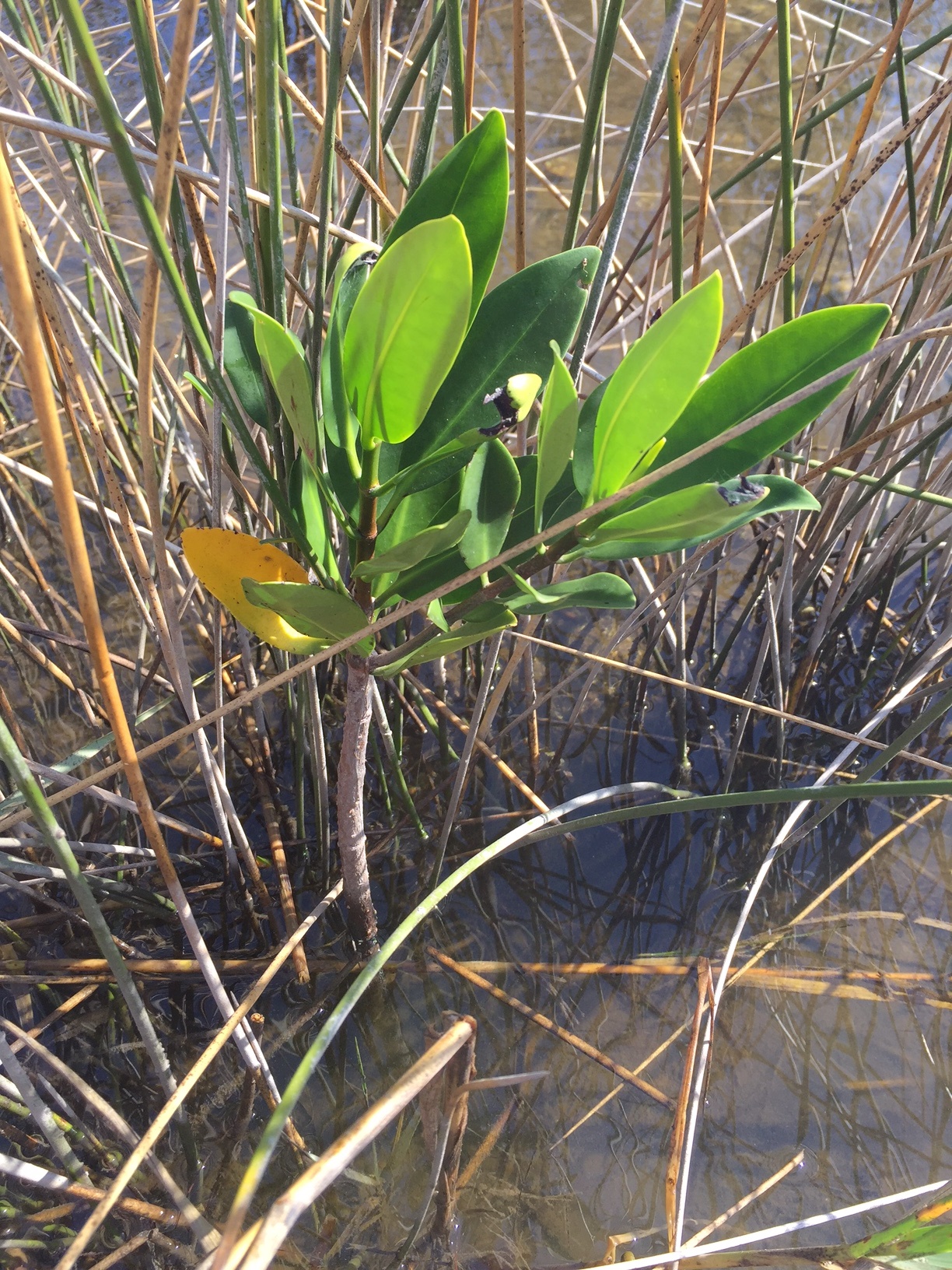
by Carrie Stevenson | Nov 3, 2017
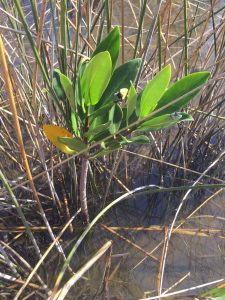
Red mangrove growing among black needlerush in Perdido Key. Photo credit: Carrie Stevenson, UF IFAS Extension
Discovering something new is possibly the most exciting thing a field biologist can do. As students, budding biologists imagine coming across something no one else has ever noticed before, maybe even getting the opportunity to name a new bird, fish, or plant after themselves.
Well, here in Pensacola, we are discovering something that, while already named and common in other places, is extraordinarily rare for us. What we have found are red mangroves. Mangroves are small to medium-sized trees that grow in brackish coastal marshes. There are three common kinds of mangroves, black (Avicennia germinans), white (Laguncularia racemosa), and red (Rhizophora mangle).
Black mangroves are typically the northernmost dwelling species, as they can tolerate occasional freezes. They have maintained a large population in south Louisiana’s Chandeleur Islands for many years. White and red mangroves, however, typically thrive in climates that are warmer year-round—think of a latitude near Cedar Key and south. The unique prop roots of a red mangrove (often called a “walking tree”) jut out of the water, forming a thick mat of difficult-to-walk-through habitat for coastal fish, birds, and mammals. In tropical and semi-tropical locations, they form a highly productive ecosystem for estuarine fish and invertebrates, including sea urchins, oysters, mangrove and mud crabs, snapper, snook, and shrimp.
Interestingly, botanists and ecologists have been observing an expansion in range for all mangroves in the past few years. A study published 3 years ago (Cavanaugh, 2014) documented mangroves moving north along a stretch of coastline near St. Augustine. There, the mangrove population doubled between 1984-2011. The working theory behind this expansion (observed worldwide) is not necessarily warming average temperatures, but fewer hard freezes in the winter. The handful of red mangroves we have identified in the Perdido Key area have been living among the needlerush and cordgrass-dominated salt marsh quite happily for at least a full year.
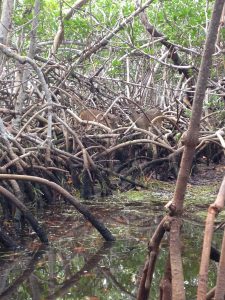
Key deer thrive in mangrove forests in south Florida. Photo credit: Carrie Stevenson, UF IFAS Extension
Two researchers from Dauphin Island Sea Lab are planning to expand a study published in 2014 to determine the extent of mangrove expansion in the northern Gulf Coast. After observing black mangroves growing on barrier islands in Mississippi and Alabama, we are working with them to start a citizen science initiative that may help locate more mangroves in the Florida panhandle.
So what does all of this mean? Are mangroves taking over our salt marshes? Where did they come from? Are they going to outcompete our salt marshes by shading them out, as they have elsewhere? Will this change the food web within the marshes? Will we start getting roseate spoonbills and frigate birds nesting in north Florida? Is this a fluke due to a single warm winter, and they will die off when we get a freeze below 25° F in January? These are the questions we, and our fellow ecologists, will be asking and researching. What we do know is that red mangrove propagules (seed pods) have been floating up to north Florida for many years, but never had the right conditions to take root and thrive. Mangroves are native, beneficial plants that stabilize and protect coastlines from storms and erosion and provide valuable food and habitat for wildlife. Only time will tell if they will become commonplace in our area.
If you are curious about mangroves or interested in volunteering as an observer for the upcoming study, please contact me at ctsteven@ufl.edu. We enjoy hearing from our readers.
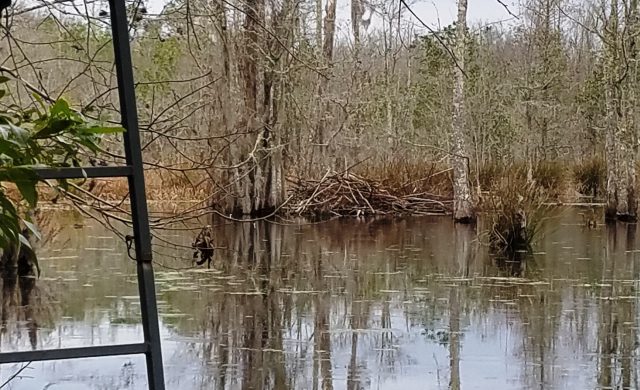
by Judy Biss | Mar 17, 2017
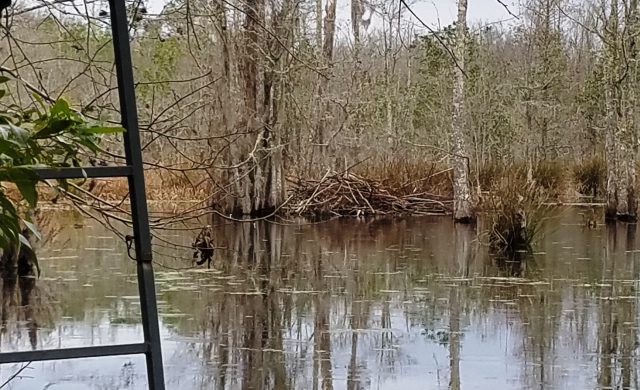
Beaver lodge, Calhoun County Florida. Photo by Judy Biss
Even though the “work” beavers do can sometimes cause frustration to land owners, they are truly amazing creatures. A number of questions have come into the Extension Office lately about managing beavers, so it is a good time to discuss a little about the history and biology of these unique animals, as well as the management options available for land owners.
Beavers in the American Landscape
Hundreds of millions of beaver once occupied the North American continent until the 1900s, when the majority had been trapped out in the eastern United States for the fur trade (Baker, B.W., and E.P. Hill. 2003. Beaver (Castor canadensis)). “Growing public concern over declines in beaver and other wildlife populations eventually led to regulations that controlled harvest through seasons and methods of take, initiating a continent-wide recovery of beaver populations.” (Baker, B.W., and E.P. Hill. 2003. Beaver (Castor canadensis)). In its current range, the beaver “thrives throughout the Florida Panhandle and upper peninsula in streams, rivers, swamps or lakes that have an ample supply of trees.” (Florida Fish and Wildlife Conservation Commission, Aquatic Mammals, Beaver: Castor canadensis).
Adaptations
Beavers are the largest rodent in North America. In Florida, they commonly weigh between 30 – 50 pounds. Beavers are considered an aquatic mammal, having adaptations such as a streamlined shape, insulating fur, ears and nostrils that close while underwater, clear membranes that cover their eyes while underwater, large webbed feet, and a broad flat rudder-like tail that aid in swimming. They can remain underwater for 15 minutes at a time! Their tree-cutting, bark-peeling front teeth grow continuously, and as a result, are continuously sharpened as they grind against the lower teeth. (Baker, B.W., and E.P. Hill. 2003. Beaver (Castor canadensis), Florida Fish and Wildlife Conservation Commission, Aquatic Mammals, Beaver: Castor canadensis).
Habitat and Behaviors
Beavers typically mate for life and live in family groups consisting of the adult male and female, and one or two generations of young kits before they are old enough to disperse on their own. They are primarily nocturnal, being active from dusk to dawn. Beavers eat not only tree bark, leaves, stems, buds, and fruits, but herbaceous plants as well. Their diet is broad and can consist of aquatic plants, such as cattails and water lilies, shrubs, willow, grasses, acorns, tree sap, and sometimes even cultivated row crops. (Baker, B.W., and E.P. Hill. 2003. Beaver (Castor canadensis)).
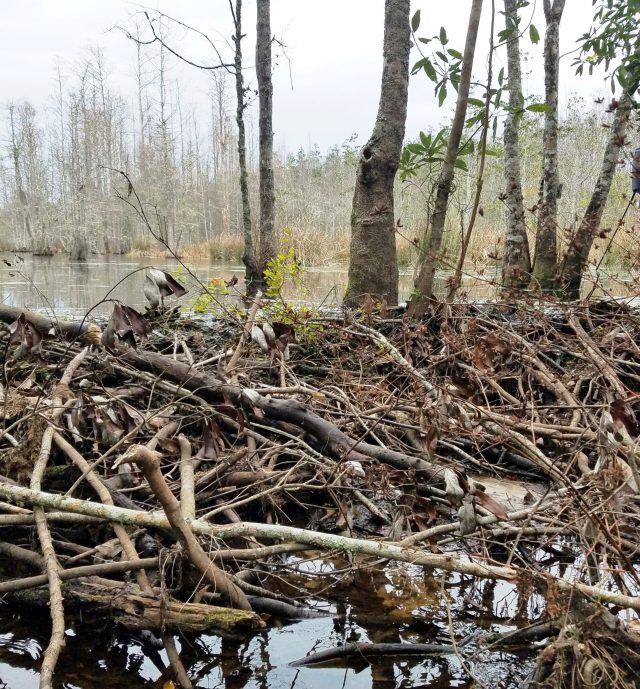
Top of beaver dam in Calhoun County FL. Water level difference is nearly 3 feet. Photo by Judy Biss
Dam and Lodge Construction
The sound of moving water triggers beavers to build, repair, or maintain their dams. (Baker, B.W., and E.P. Hill. 2003. Beaver (Castor canadensis)). The two main structures they build are the water-slowing dam and their living quarters or lodge. The lodge is separate from the dam and is oftentimes located in the stream or pond bank. “The ponds created by dams also provide beavers with deep water where they can find protection from predators — entrances to dens or lodges are usually underwater. Some beavers in Florida do not build the massive stick lodges associated with northern colonies. Instead, they are more likely to live in deep dens in stream banks…” Florida Fish and Wildlife Conservation Commission, Aquatic Mammals, Beaver: Castor canadensis).
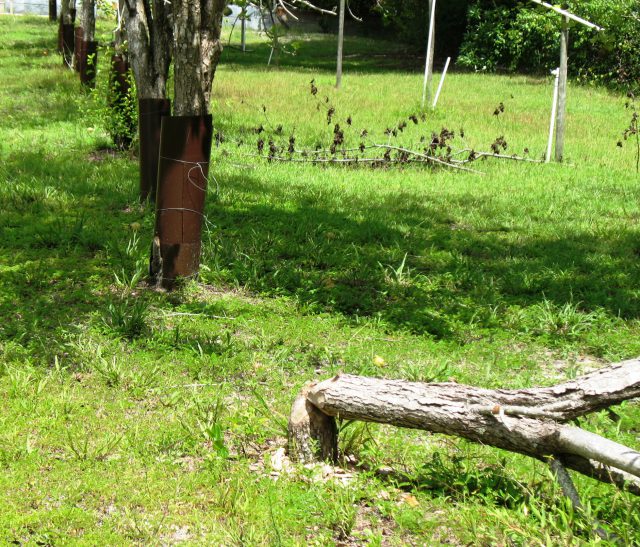
Pear tree felled by beaver in Calhoun County FL. Photo by Judy Biss
Impacts
Beavers are called “nature’s engineers” for good reason. Their tree cutting and building behaviors certainly alter surrounding landscapes. Outside of any connection to human civilization, their activities tend to increase diversity and habitat options for both plants and animals. Many scientists have examined the intricate biological and ecological effects beavers have on surrounding landscapes. Their activities in our backyard, however, do not always result in positive outcomes. Often, beavers are triggered to build dams in running water through road culverts causing significant impacts to road drainage, and surrounding flood management. Their construction of dams along creeks can flood farm fields and woodlands. Their feeding and tree cutting can kill desired trees in nearby timberland and orchards.
Management Options for Land Owners
The Florida Fish and Wildlife Conservation Commission (FWC) publication, “Living with Beavers” provides excellent advice, along with a summary of the regulations regarding this native wildlife species. As per this document, “The beaver is a native species with a year-round hunting and trapping season in Florida.” Beaver hunting and trapping regulations can be found on the FWC Furbearer Hunting and Trapping website. A beaver can be taken as a nuisance animal, if it causes or is about to cause property damage, presents a threat to public safety, or causes an annoyance in, under, or upon a building, per Florida Rule 68A-9.010.” Other recommendations from this FWC publication are:
- “Beaver dam removal provides immediate relief from flooding and can be the simplest and cheapest way of dealing with a beaver problem. However, beavers often quickly rebuild a dam as soon as it is damaged. “
- “When removing a dam is infeasible or unsuccessful, installing a water level control structure through the dam can allow for the control of water flow without removing the dam. This technique also reduces the likelihood of the beaver continuously blocking water flow. For technical assistance, contact a wildlife assistance biologist at a regional FWC office near you.”
- “If a beaver dam is blocking a culvert or similar structure, installing a barrier several feet away from the culvert can be the most effective solution. This prevents the beavers from accessing the culvert to dam it. Please contact a wildlife assistance biologist at a regional FWC office near you for technical assistance.”
- “Protect valuable trees and vegetation from beaver damage by installing a fence around them or wrapping tree trunks loosely with 3-5 feet of hardware cloth or multiple wraps of chicken wire. This prevents the beavers from chewing on the trees and other plants.”
- “Lethal control should be considered a last resort.”
FWC also points the reader to this publication from Clemson University Cooperative Extension Service, Department of Aquaculture, Fisheries and Wildlife, “The Clemson Beaver Pond Leveler.” This publication provides diagrams and a list of materials needed to construct a device which is designed to “minimize the probability that current flow can be detected by beavers, therefore minimizing dam construction.”
All questions regarding beaver management should be directed to your local FWC Regional Office. Land owners can also request a list of Nuisance Wildlife Trappers available in their area:
FWC Northwest Region Office
3911 Highway 2321
Panama City, FL 32409-1659
(850) 265-3676
Links to the references used for this article:



















